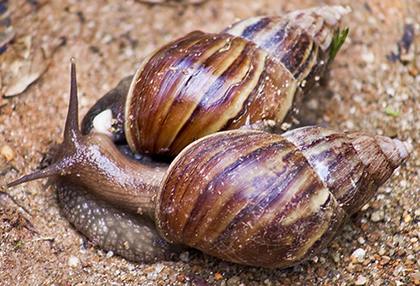2018 price of snail in Ghana

Ghana is a major producer of snails in Africa, with a total production of 39,000 tonnes in 2018. The snail industry in Ghana is growing, with snail production increasing by 8.5% in 2018 compared to 2017.
The production of snails in Ghana is mainly done by small-scale farmers. It is estimated that there are more than 20,000 small-scale snail farmers in the country. These farmers cultivate snails in fields, with most of the farms located in the Greater Accra, Ashanti, and Eastern regions.
Snail farming in Ghana is highly profitable and has the potential to create jobs and income for the local population. The snails are mostly harvested for their meat and shells, which are used in the production of medicines, cosmetics, and crafts. In addition, snails are also used as feed for poultry and livestock.
Types of snail reared in Ghana
In Ghana, there are a variety of snail species that are reared, each with its own unique characteristics. They provide a valuable source of nutrition and sustenance, as well as medicinal purposes. They are all unique in their own way, and provide a variety of flavors and textures to Ghanaian cuisine. Let’s look at four of the popular snails that are mostly reared in Ghana.
1. Helix Aspersa
Helix Aspersa, also known as the garden snail. This species is mainly reared for food, and is considered the tastiest of all the snails reared in Ghana. The Helix Aspersa is a small, brownish snail that grows to a maximum size of 1.5 inches. It is fairly easy to cultivate, and it is often found in gardens, fields, and agricultural areas. The flesh of this species is considered to be particularly delicious, and it is often cooked in various soups, stews, and sauces.
2. Achatina Fulica
Giant African Land Snail, or Achatina Fulica. This species is much larger than the Helix Aspersa, reaching up to 8 inches in length. It is also more difficult to cultivate, as it requires more maintenance and care. However, its flesh is considered to be quite delicious, and is often used in various dishes, including stews and sauces.
3. Achatina Achatina
African Giant Snail, or Achatina Achatina. This species is similar to the Helix Aspersa, but much larger, reaching up to 12 inches in length. It is also more difficult to cultivate, and requires more attention and care. Its flesh is also considered to be quite tasty, and is often cooked in various dishes, including stews and sauces.
4. Achatina Marginata
Giant African Snail, or the Achatina Marginata. This species is much larger than the other three species, reaching up to 16 inches in length. It is also more difficult to cultivate, and requires more care and attention. Its flesh is considered to be quite delicious, and is often cooked in various dishes, including stews and sauces.
Challenges of Snail farming in Ghana
1. Access to land
Access to land is one of the most significant challenges for snail farming in Ghana. Many rural farmers are unable to access the suitable land for snail farming due to the lack of adequate infrastructure, access to credit, and the cost of land in many rural areas. In addition, the lack of access to land means that farmers may not be able to use the traditional methods of snail farming, such as burying snail shells in the ground, which can limit their ability to produce large volumes of snails.
- Advertisement -
2. Access to finance and capital
Access to finance and capital is another major challenge for snail farming in Ghana. Many farmers do not have the capital to invest in snail farming, and those that do often lack the necessary knowledge and skills to manage a successful snail farm. This can make it difficult for farmers to purchase the necessary resources and equipment to run their farms, such as feed, housing, and other inputs.
3. Lack of knowledge of snail farming techniques
The lack of knowledge of snail farming techniques is another challenge facing snail farmers in Ghana. While many farmers are familiar with traditional methods of snail farming, such as burying snail shells in the ground, many of these techniques are not suitable for large-scale production of snails. Additionally, there is limited access to training and support for farmers to learn new techniques, such as the use of cages and tanks, which can improve the efficiency and productivity of snail farming.
4. Disease management
Disease management is another major challenge for snail farming in Ghana. Snails are susceptible to many diseases, such as parasites, fungal infections, parasites, and bacteria, which can quickly spread throughout a farm and lead to significant losses. The lack of knowledge of disease management, as well as a lack of access to veterinary services and treatments, can make it difficult for farmers to protect their farms from disease.
5. Marketing and distribution of snails
Marketing and distribution of snails is a major challenge for snail farmers in Ghana. Many farmers lack the necessary skills and resources to effectively market and distribute their products. Also, the lack of a well-developed infrastructure for transportation and storage can make it difficult to move snails from the farm to market. As a result, many farmers are unable to access the markets necessary to generate sufficient profits from their farms.
2018 price of Snail in Ghana
In 2018, the price of snails in Ghana were steadily increasing due to the rise in demand for snails in the country. Snails were sold around GHS 10 to GHS 15 per kilogram. However, the price vary depending on the quality and size, but the average price for snails were around GHS 10 to GHS 15.
As Ghana continues to develop, the demand for snails is expected to continue to increase, meaning that the price of snails in the country will likely continue to rise. This is great news for Ghanaian farmers, as it will provide them with a reliable source of income, and for consumers, as it will give them access to a nutritious and healthy food source.
Factors that affected the price of snail in 2018
1. Pricing
The availability of snail in Ghana has a large impact on pricing. When supply is limited, prices tend to rise. This is particularly true in the dry season, when fewer snails are available. On the other hand, in the rainy season when the snails are more abundant, prices tend to drop. This means that the demand and supply of snails can have a major impact on the price.
2. Cost of production
Another factor that affects the price of snail in Ghana is the cost of production. Snail farming requires a significant investment of time and money, and the cost of production can vary greatly from farm to farm. As the costs of production increase, so does the price of snail.
3. Weather
Snail production in Ghana is largely dependent on the weather, as snails require a humid environment to survive. When the weather is too dry, the snails can die off in large numbers, resulting in a decrease in supply and an increase in price. When the weather is too wet, snails can be more prone to disease and infection, which results in an even sharper decline in supply and a consequent increase in price.
4. Government policies
The government also plays a role in regulating the price of snails in Ghana. In an effort to protect the interests of small-scale snail farmers, the government has limited the amount of snails that can be harvested in a given area. This has the effect of controlling the supply of snails, thus keeping the price of snails from getting too low.
5. Environmental conditions
Environmental conditions can also have an effect on the price of snails. For example, when the environment is polluted or damaged, the snails may be unable to survive, thus reducing the supply and increasing the price.
Conclusion
2018 was a difficult year for snail prices due to a number of factors. These included increased competition from imported snails, a decrease in demand due to changing dietary preferences, the spread of the African land snail, and the impact of weather and natural disasters. Despite these challenges, the snail market was able to adapt and remain resilient. By utilizing cost-saving strategies and adjusting production to meet changing demands, the snail industry was able to survive the difficult year and look forward to a more prosperous future.


